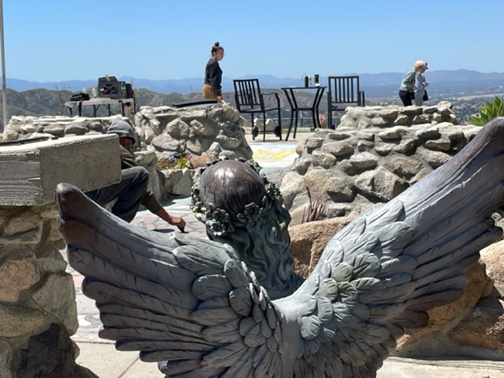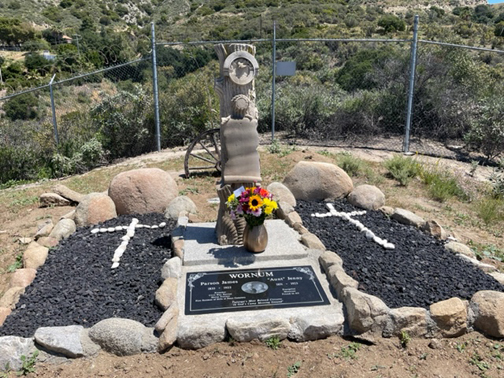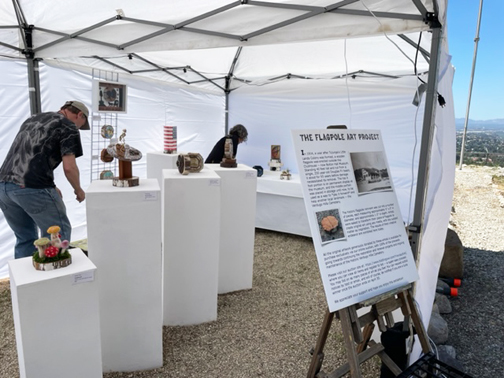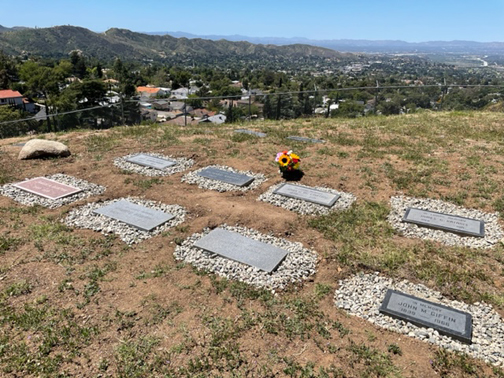
Photos by Mary O’KEEFE
By Mary O’KEEFE
After many, many hours of weed pulling, organizing, fundraising, sweeping, raking and backbreaking boots-on-the-ground volunteering, the Verdugo Hills Cemetery celebrated its grand centennial event on Saturday.
Craig Durst took the lead in not only developing a vision to restore and repair the historical cemetery but he also organized volunteers in addition to performing a lot of outreach to bring respect to this neglected cemetery high on a hill in Tujunga.

The centennial event included walking tours and video presentations of the cemetery’s past including the 1978 flood that devastated the cemetery. The “Hills of Peace” cemetery, as it was known, was established in 1922 when local pioneer Marshall Hartranft donated a four-acre parcel of land in Tujunga for his friend Parson James Wornum, who had died that year. Wornum and his wife, known as “Aunt” Jenny, were laid to rest at the cemetery.

The cemetery has struggled for years with mismanagement by caretakers, some who lived on the cemetery grounds, but it was the flood that most remember.
In 1978 the area received a lot of rain, which caused a flood. The cemetery overall was affected but the southwest area gave way causing caskets and, in some cases, human remains to float down the hillside, mixed in mud and rainwater.
The remains were found in local neighborhood yards and as far away as Foothill Boulevard businesses. No one wanted to take responsibility for this tragedy as jurisdiction lines were discussed and debated but Los Angeles County Coroner Dr. Thomas Noguchi wanted to do something to help. He arrived with some volunteers and began finding and categorizing the remains. A video of what he witnessed and why he responded the way he did was shared at the centennial event.

The flood’s aftermath is a gruesome tale but, for families of loved ones whose final resting place was disturbed, it was painful and frustrating. Many came after the flood in an attempt to try to find their loved one’s headstone and hoped the remains were still in place.
In 1966 Jay Johnson was 6 years old when his mother, Earline, passed away. She was buried in the south area of the cemetery but when the flood occurred no one knew where their loved ones were – including Earline’s family.
Johnson came to the cemetery with his dad immediately to make sure his mom’s grave was still there. He described the scene as a chaotic “mess.”
“My dad brought me here,” Johnson said. “There used to be an A-frame building here.” He referred to a building that once stood at the location and was used for funerals in the 1960s.
“The hills were gone,” he said. “The [building] was full of head plates [markers]. We were [finally] able to find hers.”
They placed the marker on her gravesite and, throughout the years, Johnson has tried to keep an eye on the grave.
“About two or three years later, there was a family living here in a motorhome,” he said.
He said many times he could not get onto the property because those in charge of it changed; he said it was really a hit and miss if he was able to get into the cemetery. There were times when caring people would let him in, and then other times the gates were just closed.
Now he feels the cemetery has gained respect, thanks to Durst and the Friends of Verdugo Hills Cemetery.
“I am so glad at what they have done,” he said. “I brought flowers and [placed] them on her grave.”
Dennis and Debbie Cant found a cousin’s name while searching the website findagrave.com.
“It was [Dennis’] cousin twice removed,” Debbie said.
Dennis’ cousin Raymond Craze was buried on the far southwest side of the cemetery that is now beyond the fenced area and where the hillside is located that was most affected by the flooding.
“We think [his remains] probably went down the hill,” she said. “He died in 1967.”
Durst had some problems finding the records of people like Raymond. He said oftentimes the way records were attained was by asking people who lived in the area if they had anyone buried at Verdugo Hills Cemetery. The disorganization and bad management over time had not left much information to go on. The remains that were found after the flood were placed in an area but were not organized and, consequently, many not identified.

With the information Durst found he and members of the Friends of the Verdugo Hills Cemetery created some gravestones and bricks with the name and date of death, when known, engraved on the bricks. These were then placed throughout the cemetery, including by the now reconstituted mausoleum. The bricks are a fundraiser that will raise money for continued projects at the cemetery.
It was one of these bricks the Cants found on the website. Dennis said this meant so much to him that his cousin is respected.
“It feels like [Raymond] is home,” Debbie added.
That is at the center of Durst’s work – not only to give a name to those who were ignored and lost for so long, but also to give those whose final resting place was at the cemetery the respect that both they and their families deserve.
There are still bricks available for purchase and still work that needs to be done as Friends of the Verdugo Hills Cemetery have many more projects they would like to complete. To find how to help visit https://friendsofverdugohillscemetery.com.
